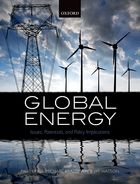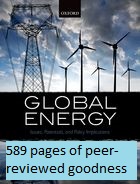A while ago, the French Chamber of Commerce in Great Britain invited me to write an article for their magazine’s (INFO) special edition on the Green Economy. Here’s the article, updated (Feb 2013) and with links added to further information
Why the Green Economy? Summary
Markets that exclude the impact on natural capital are distorted. Markets that exclude the costs of pollution are distorted. Markets that allow the Tragedy of the Commons are distorted. These distorted markets represent economic efficiency, and leave us all worse off.
The polluter-pays principle corrects the market distortion caused by unpriced pollution. Joint-stewardship agreements allow us to sustainably manage common resources, preventing the Tragedy of the Commons. Tracking changes to the value of our natural capital base is just as important as tracking transaction values: both represent changes to our wealth.
The Green Economy, in all those forms, is here because it fixes problems that have been accumulating for decades. Why the Green Economy? Because in the long run, the Green Economy leaves us better off, environmentally and economically.
Background to the Green Economy
The Green Economy is worth hundreds of billions of pounds (euro / dollars) each year; it spans many sectors including the most fundamental ones of energy, food and water supplies; and in the last fifty years, it’s gone from fringe to mainstream, growing in value and coverage each year. For example, in 2011, global investment in renewable energy was US$257bn; and there are electric cars on the market that can out-run a Porsche.
But the Green Economy has been around for quite some time, and its academic foundations, in the “polluter-pays principle” dates back to the early decades of the twentieth century. However, more recently, the problems have become global in scale, and the solutions have required international co-operation, for example in banning the industrial production of some of the worst ozone-depleting chemicals. The next wave of problems and solutions dwarfs what has gone before, requiring revolutionary changes to how we generate electricity, how we heat our homes and offices, how we power our transport systems, how we manage our livestock and fertilise our crops. The economic risks (and opportunities) are orders of magnitude greater than what has gone before.
But how did we get to this state?
The market encourages innovation, to bring down costs. One way to bring down costs, is to externalise them: that is to say, to get others to pay them, so that the costs are removed from the chain of production that ends up as goods on the shelf. That way, the costs can be removed from the price that the customer pays at time of purchase, leaving a lower price and higher profit. If a change in production would result in lower costs and higher pollution, then that change will happen whenever that pollution is unregulated and untaxed. Economists have a phrase for these externalised costs: negative externalities. Profit-maximising must lead to costs being externalised wherever possible, at least, insofar as risks to corporate reputation allow.
But these negative externalities have consequences that are not just environmental, but economic too. When some costs are ignored, the result is an inefficient allocation of resources.
Environmental economics, a theoretical foundation stone of the Green Economy, frames the situation in terms of an additional body of assets in addition to the capital found on companies balance sheets: these additional assets are those common to all of us – the oceans, the atmosphere, and so on – they are our natural capital. Just as with corporate capital, natural capital has an economic value. And activities that decrease the value of our natural capital, damage humankind’s balance sheet.
For example, negative externalities in power generation have resulted in a situation where the price of electricity has been cheap, relative to its actual cost. Now, that’s small comfort, when people are facing the coming winter with rising utility bills, but nevertheless true: a large part of the cost of our electricity has been externalised, so that we don’t pay for it in our bills. We pay for it instead in environmental degradation, in the dangerously rising emissions of greenhouse gases. And, as with any normal product, under-pricing leads to over-consumption of that product, and under-consumption of the substitutes. Which in turn leads to over-investment in its production, and under-investment in production of the substitutes. In the case of power generation, that means we’ve systematically under-invested in renewables and energy efficiency, and over-invested in the oil, coal and gas industries. This is economically inefficient, and has run up large debts on our environmental balance sheet: we have depleted some of our natural capital (the finite reserves of fossil fuels), and degraded our atmosphere (again, reducing the value of natural capital). And those debts will have to be paid for, out of future economic productivity.
We risk losing all that we have built up to date, if we carry on with business as usual: the impact assessments for higher climate-sensitivities and higher impact-sensitivities show a loss of global GDP that could exceed 90%. We don’t know how likely these higher sensitivities are: we are tangoing through a minefield. We do know that the costs of avoiding climate-change crisis, (even at much lower impact sensitivities), are much lower than the costs incurred as a result of such a crisis.
The economic imperatives that lead to the spiralling of negative externalities into an environmental crisis is well-documented: back in 1968, the “inevitable” tragedy of the commons was first written of in scientific journals: that a resource used by all but owned by none, would inevitably be over-used until it turned to dust. Though this was not the first description of the phenomenon; approximately 2300 years previously, Aristotle wrote:
“that which is common to the greatest number has the least care bestowed upon it.”
Economic solutions to economic problems
The inevitability of the tragedy of the commons became economic orthodoxy. However, more recently, Elinor Ostrom documented several cases showing that the tragedy of the commons was not inevitable. In many cases, communities had formed joint-stewardship agreements to sustainably manage common resources, such as fishing grounds, groundwater supplies, and grazing commons. They used frequent mutual monitoring and discussions between themselves to ensure that agreements were kept, and offenders were sanctioned with penalties determined and agreed in advance by all. Ostrom won a share of the 2009 Nobel memorial prize in economics for her work.
This common stewardship is one form of Green Economy – complementing other solutions to the problems of negative externalities: those other solutions include taxing or imposing quotas on pollutants, subsidising cleaner alternatives, privatising property rights, and nationalising industries that need cleaning up. Even without a crisis, negative externalities are economically inefficient: when pollution goes unpriced, we’re all worse off.
The Green Economy, in all those forms, is here because it fixes problems that have been accumulating for decades. Why the Green Economy? Because in the long run, the Green Economy leaves us better off, environmentally and economically.

